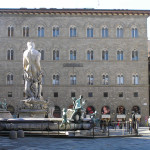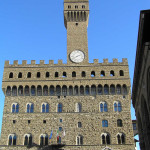Questo articolo è disponibile anche in:
![]() Français
Français ![]() Deutsch
Deutsch ![]() Español
Español ![]() Italiano
Italiano
Piazza della Signoria is an open-air museum which, at every step, offers glimpses and panoramas of particular beauty. In this square there are testimonies of a thriving past and architectural treasures of enormous value. Which, then, are found a bit all over Florence. Famous in the world since ancient times, and probably the most important cultural center in Italy. Cradle of art and the Italian language. Treasure chest of an invaluable artistic heritage and birthplace of famous people all over the world such as Giotto, the great painter, and Dante Alighieri, father of the Italian language.
THE CENTER OF POLITICAL POWER OF THE CITY OF FLORENCE
Piazza della Signoria has been the center of the political power of the city since the Middle Ages. The square is all centered on the Palazzo Vecchio, which represents its main monument. The unusual “L” shape of Piazza della Signoria is the result of centuries of transformations, which have always favored the most important monument of the square itself, the Palazzo Vecchio. Built from the end of the thirteenth century as the seat of the Priors of the Arts. In the fifteenth century it became the seat of the Signoria and from 1540 to 1565 it hosted the powerful Medici family, the lords of the city, until their definitive move to Palazzo Pitti, a new palace beyond the Arno river.

AN OPEN SKY MUSEUM
The original Loggia della Signoria also overlooks the square, created as a place for public assemblies of the Municipality. In the sixteenth century it was transformed by Cosimo I de’ Medici into an open gallery with Roman and Renaissance statues. A real open-air museum with ancient statues, including masterpieces such as the Perseus by Benvenuto Cellini. In the center of the square stands the so-called “Biancone”, the work of Bartolomeo Ammannati, a majestic fountain with satyrs, marine deities, characterized by the marble statue of the god Neptune, nicknamed by the Florentines “Biancone” for his awkwardness. There is also the bronze equestrian monument of Cosimo I by Giambologna.

On the square are the palace of the Tribunale di Mercanzia, the palace Condotta, the palace Uguccioni, the palace Guiducci and the palace of the Assicurazioni Generali. On the side towards the Arno, Piazza della Signoria is delimited from the Uffizi, one of the most famous and visited museums in the world. Masterpiece of Vasari, the palace was designed as the headquarters of administrative records of the State. In 1581 Prince Francesco I ordered that the grand-ducal collection, housed in the Gallery of the building, were visible to anyone who requests it.
Thus developed the modern concept of museum as a place of public enjoyment of works of art and the Uffizi Gallery became, therefore, the oldest museum in Europe. Today is the biggest collection of Italian paintings in the world, including masterpieces by Giotto, Paolo Uccello, Botticelli, Michelangelo, Raphael, Titian, which is flanked by hundreds of paintings, of the major international artists.
Questo articolo è disponibile anche in:
![]() Français
Français ![]() Deutsch
Deutsch ![]() Español
Español ![]() Italiano
Italiano









